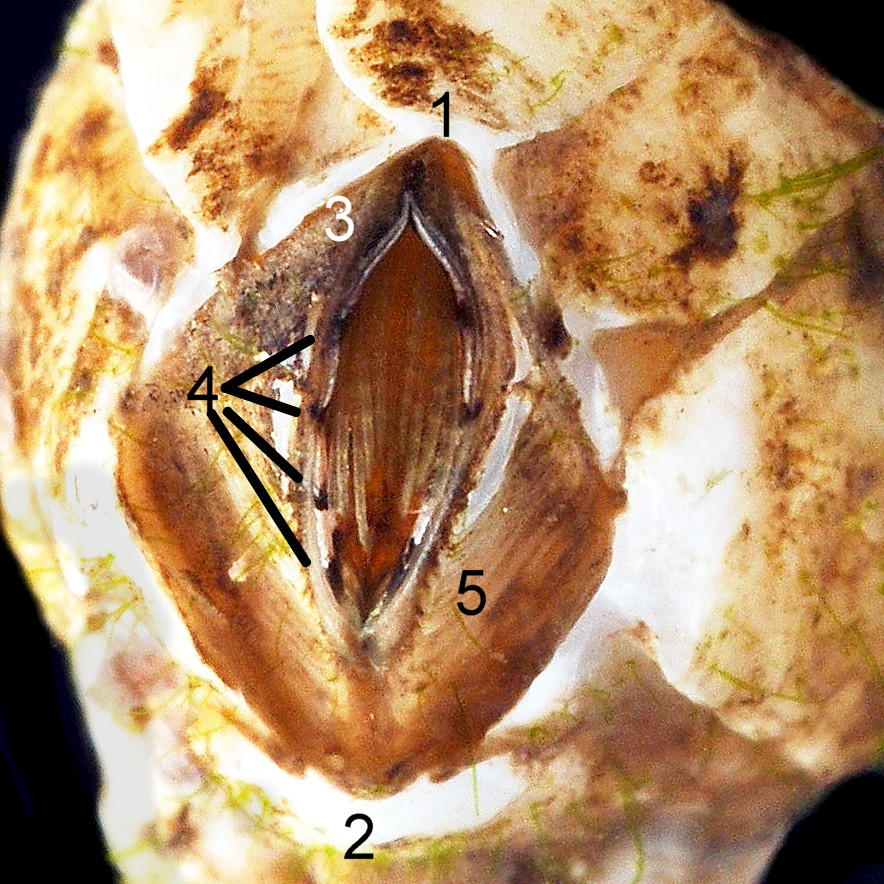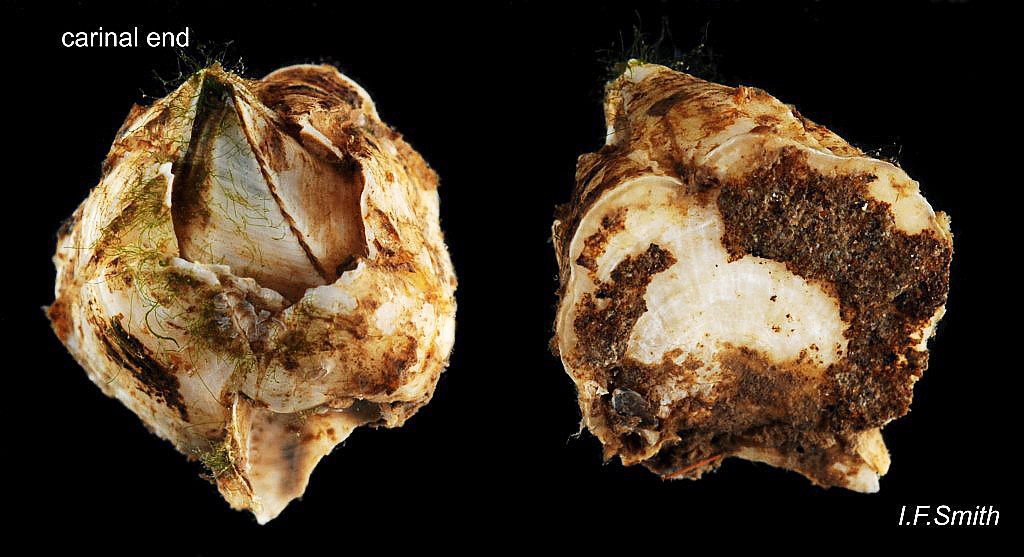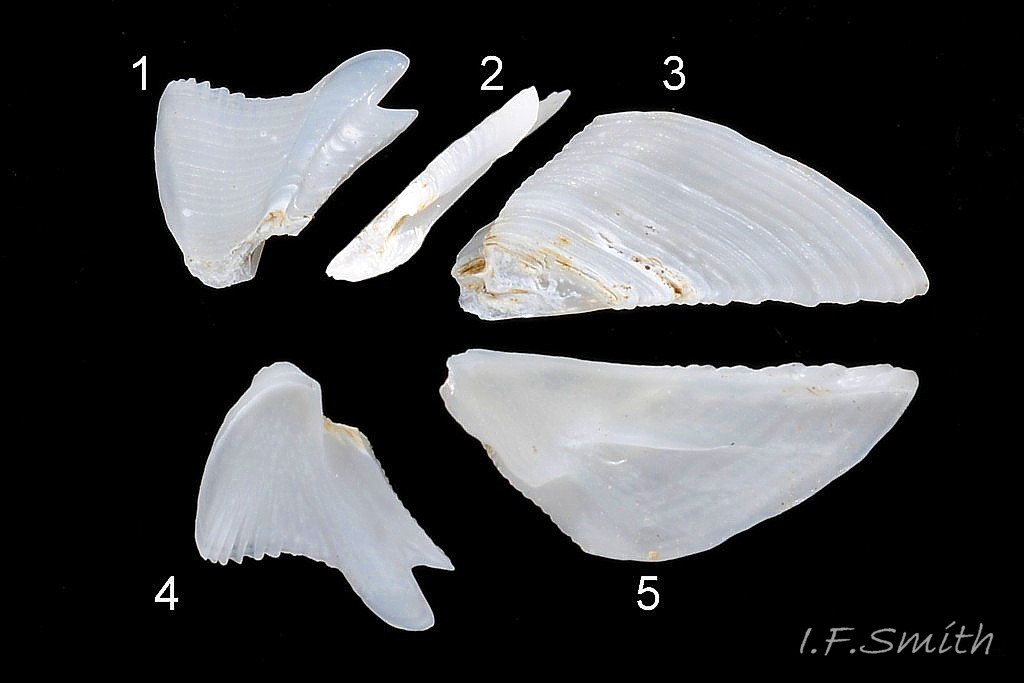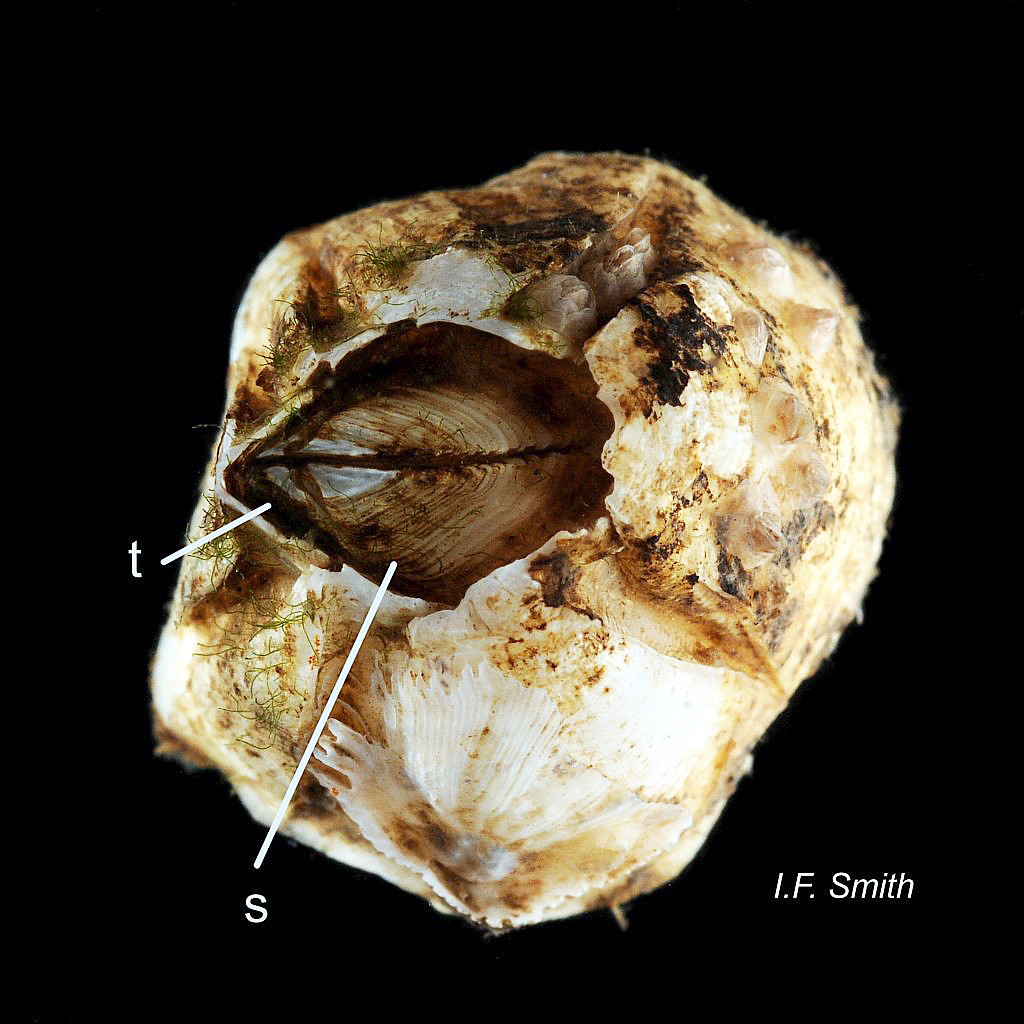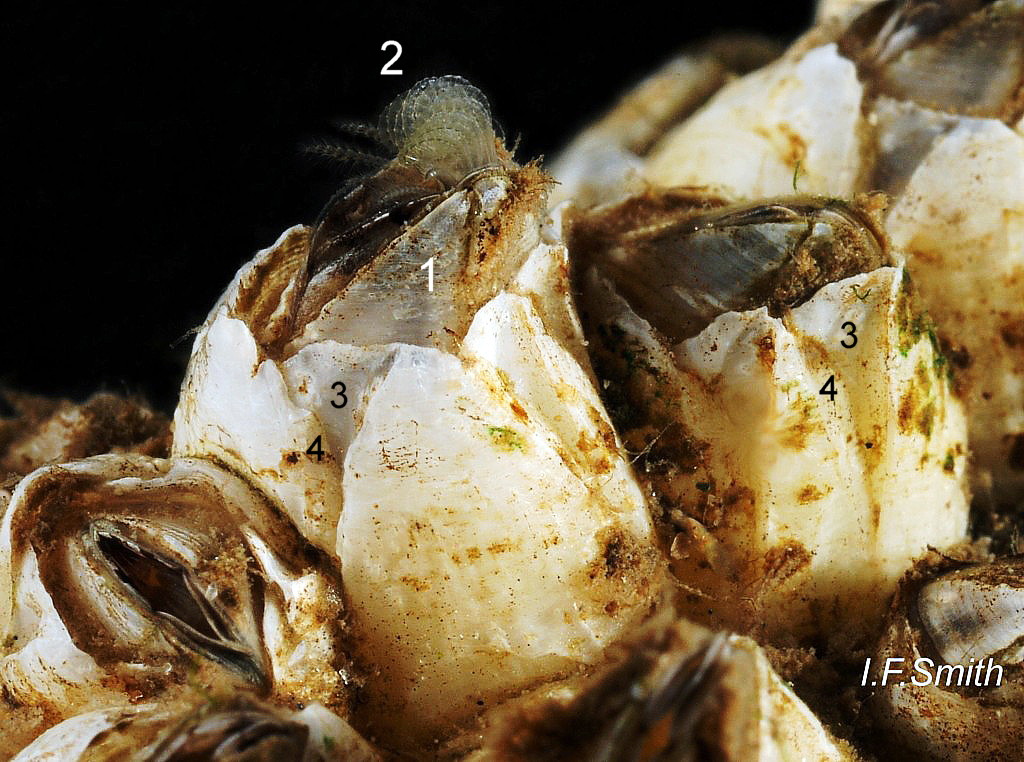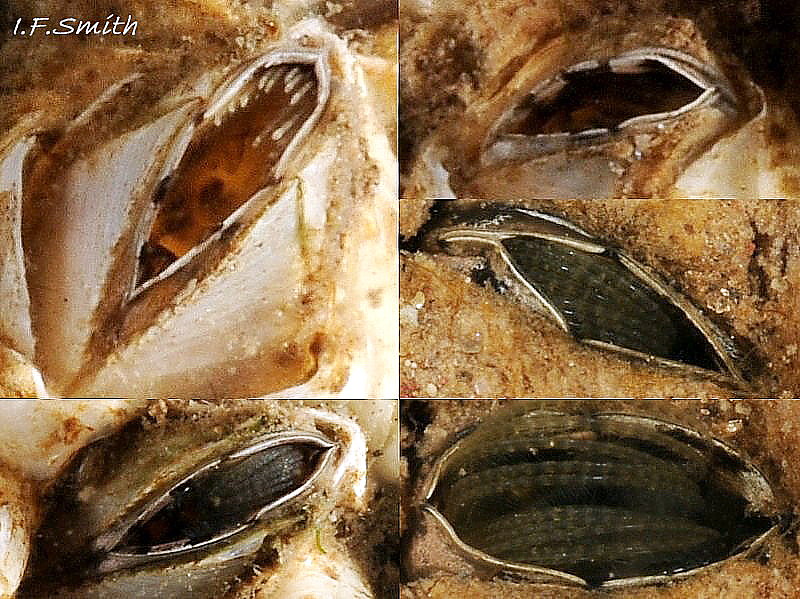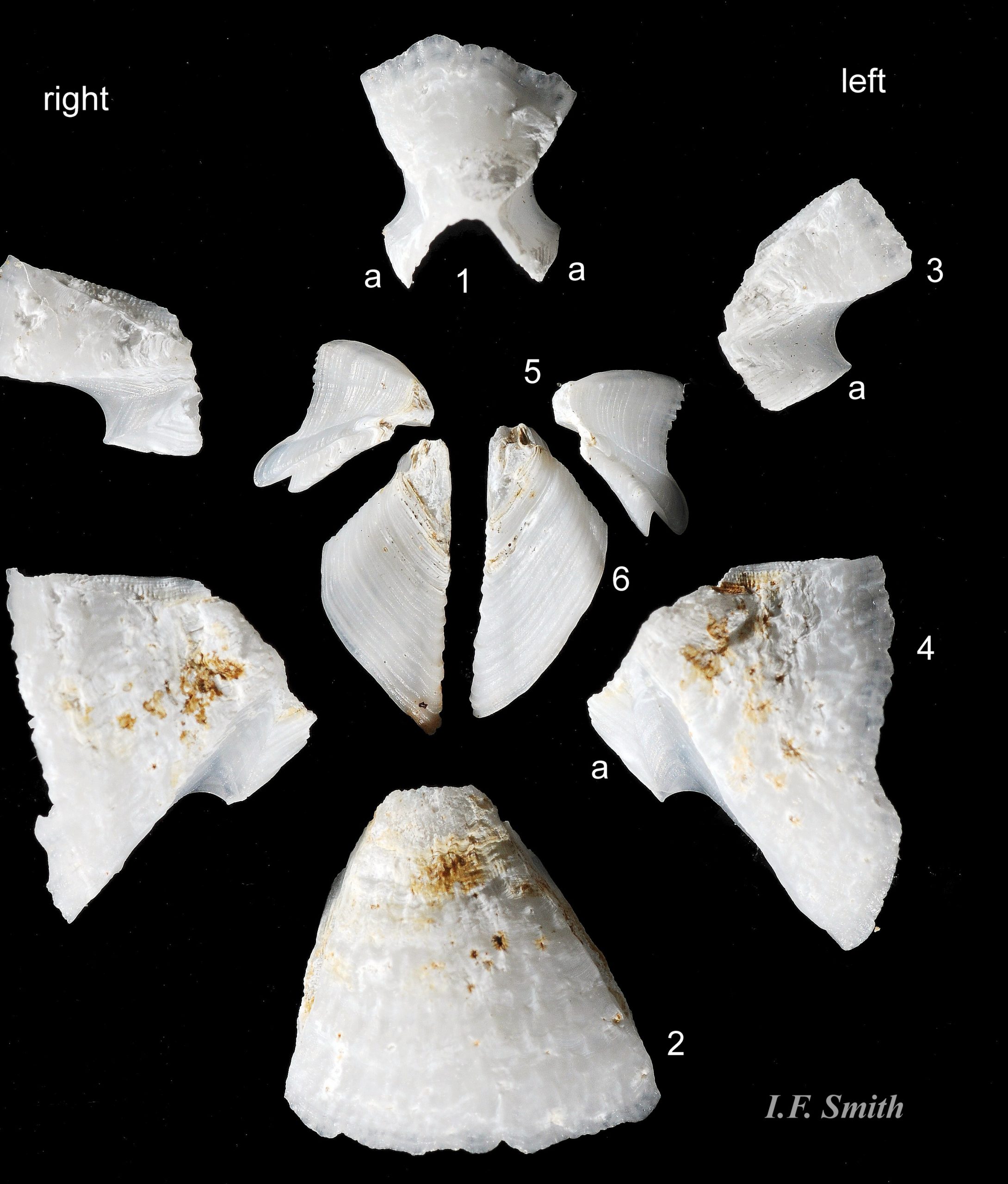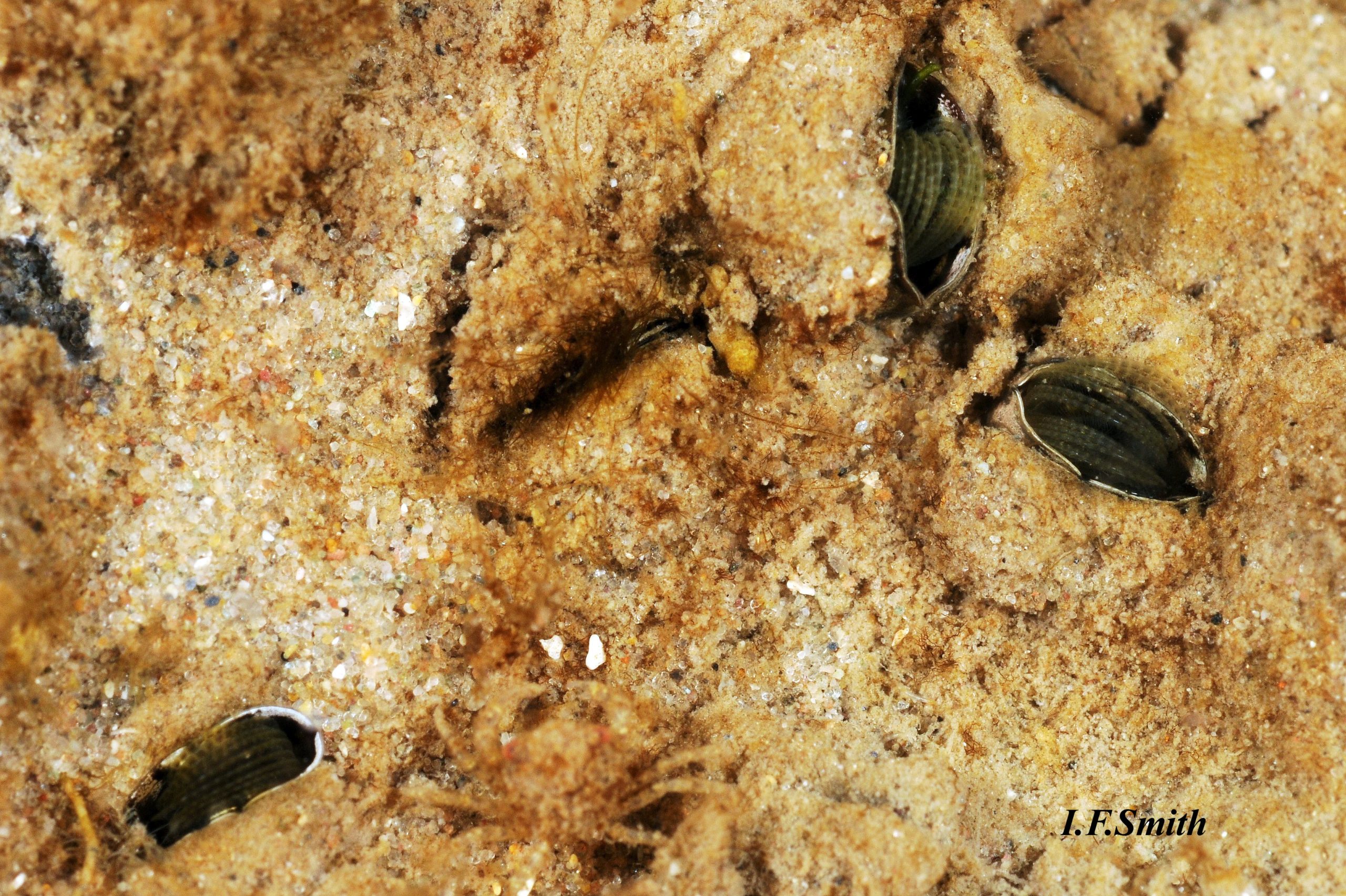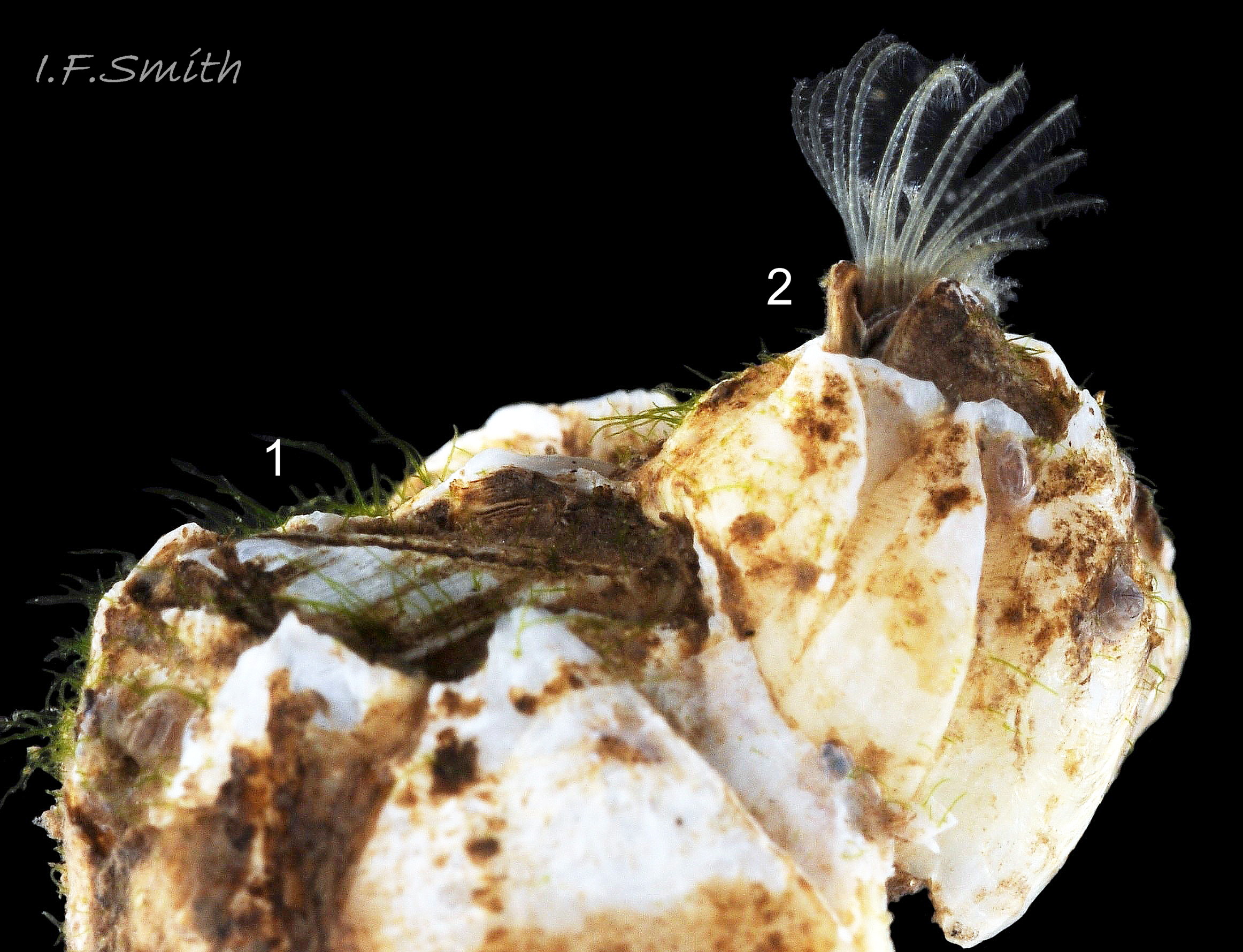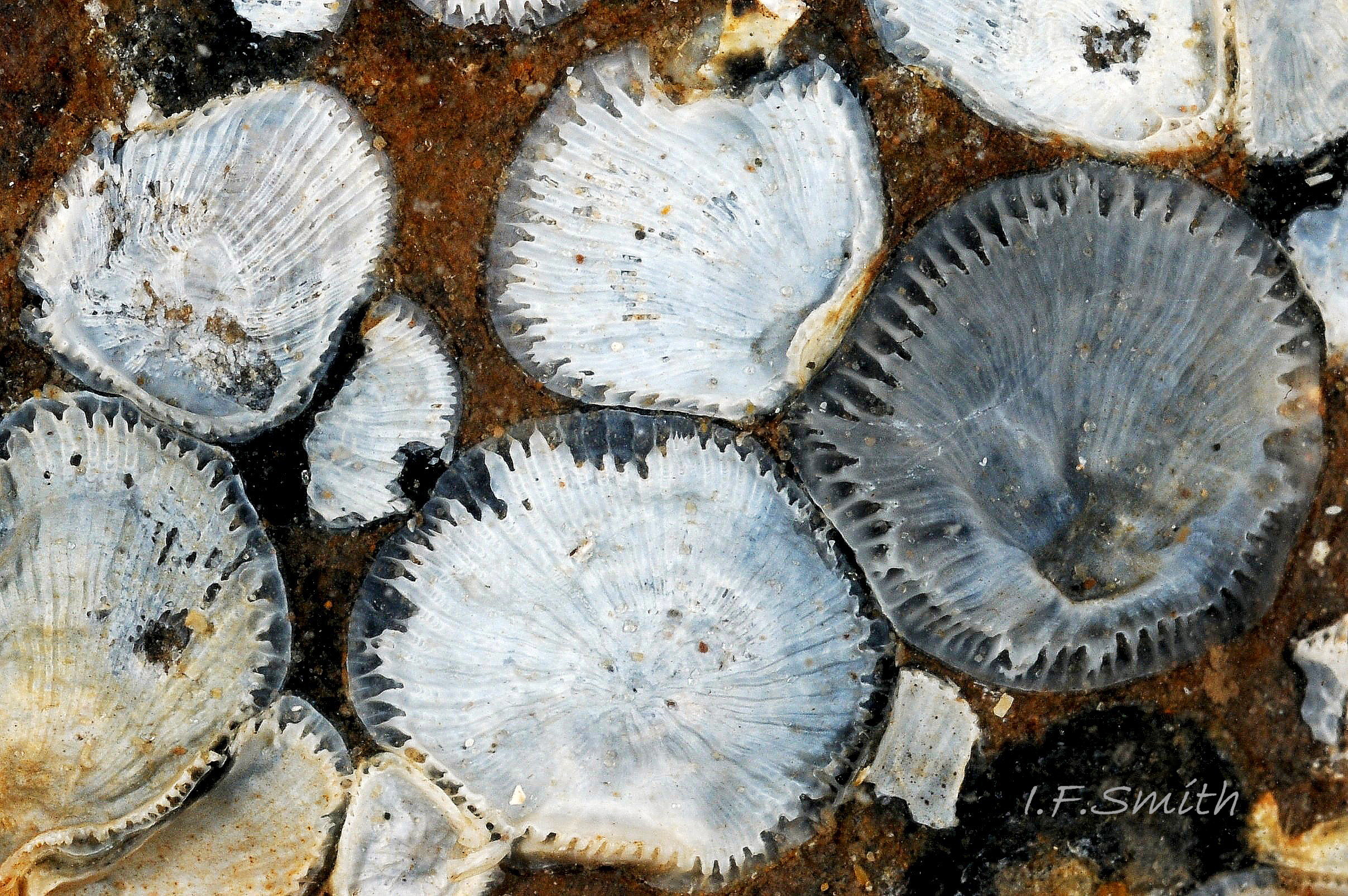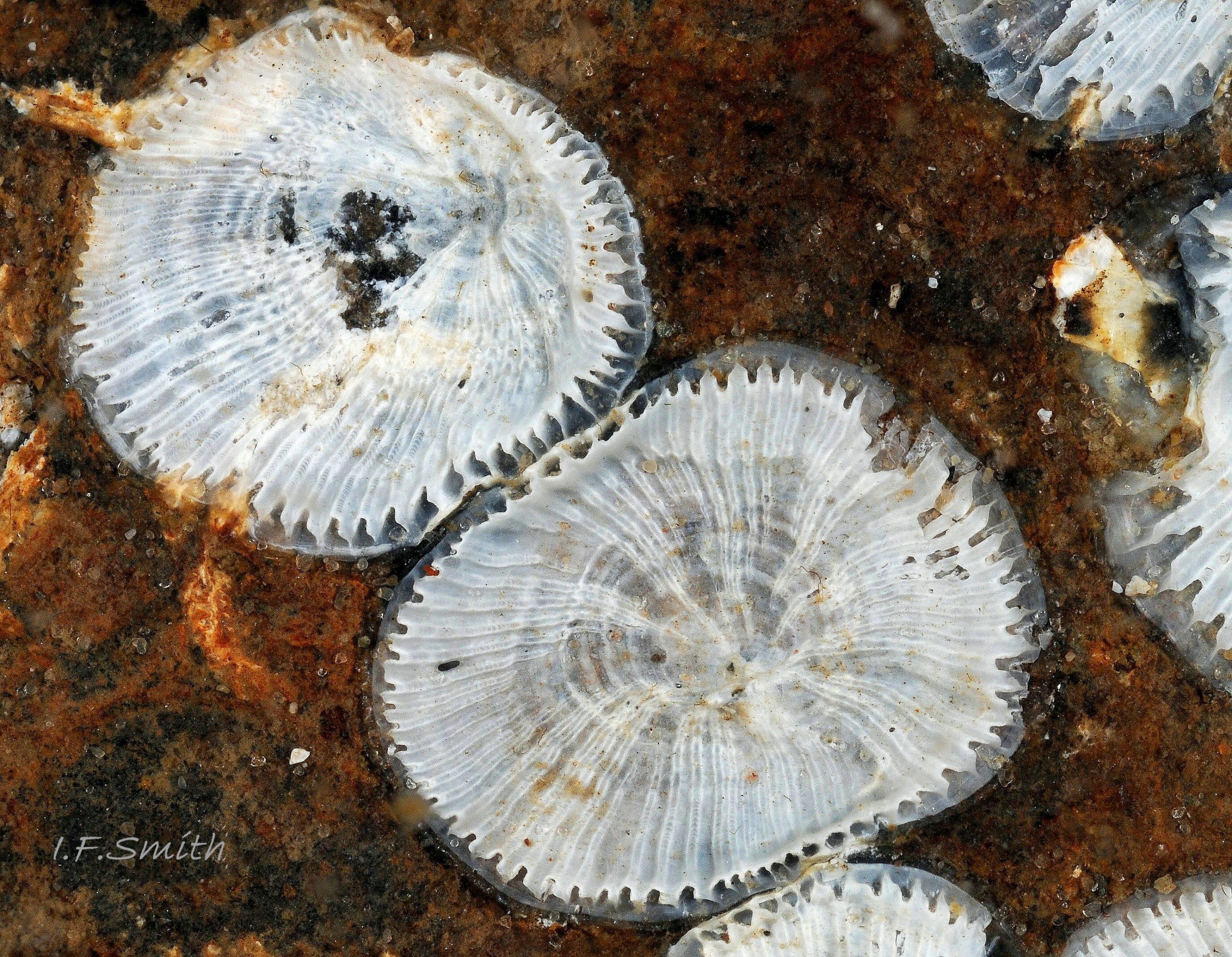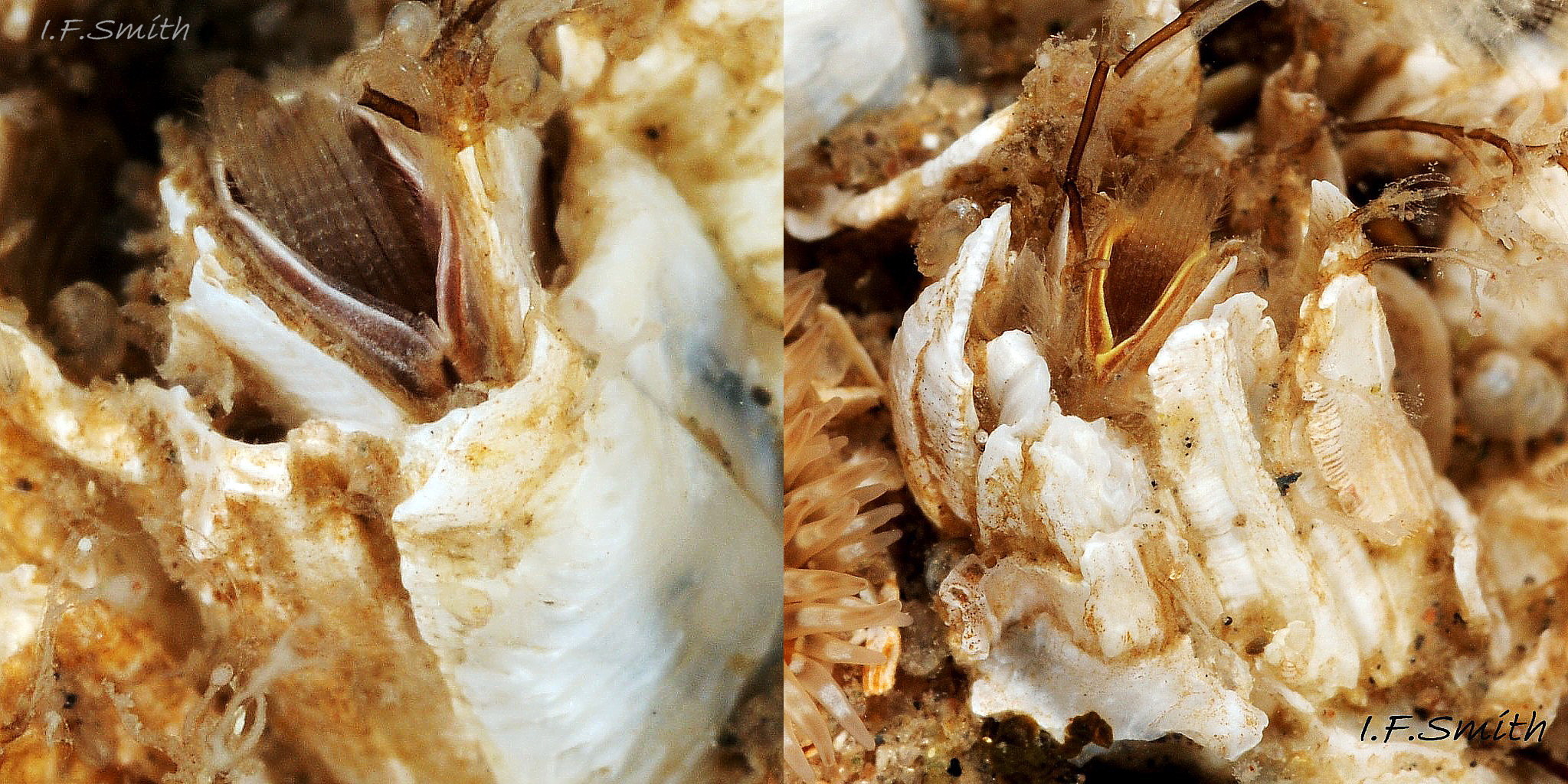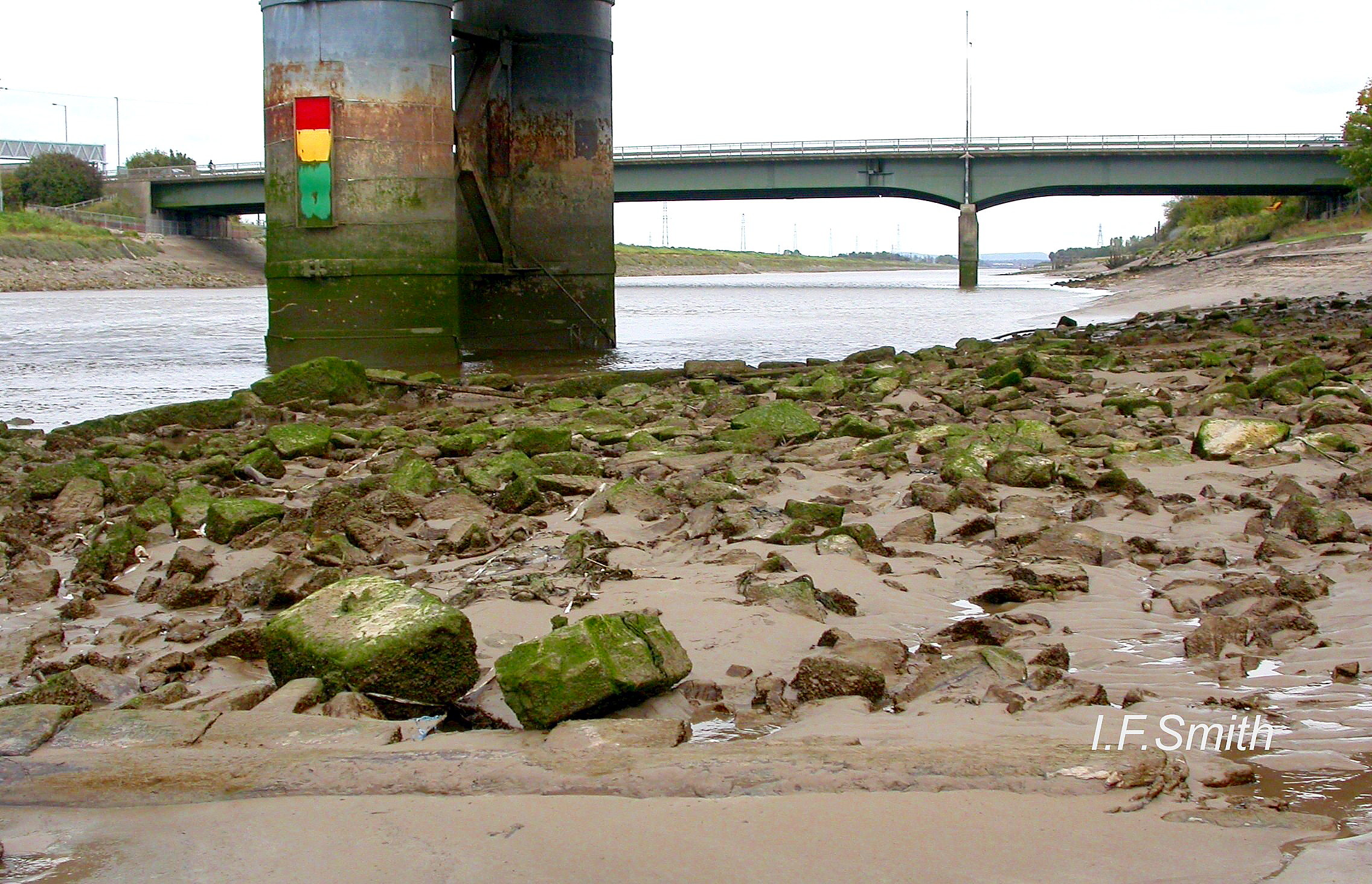Click image to enlarge with full caption. Main text below slider.
Amphibalanus improvisus (Darwin, 1854) Revised 2021 I.F. Smith
Synonym Balanus improvisus Darwin, 1854
Current taxonomy: World Register of Marine Species. www.marinespecies.org/aphia.php?p=taxdetails&id=421139
Vernacular names
Bay barnacle, River barnacle, Little ivory barnacle (English ), Crachen yr aber (Welsh), Brakvandsrur (Danish), Brakwaterpok (Dutch), Petite balane ivoire (French), Kleine Elfenbeinseepocke, Brackwasser-Seepocke (German), Brakkvannsrur (Norwegian).
Glossary below
Description
Opercular aperture
The carinal end is acute and usually close to the perimeter of the barnacle. The rostral end is often rounded 01 Amphibalanus improvisus , or un-angled, resulting in a pentagonal aperture 02 Amphibalanus improvisus .
Opercular valves
There are four valves; two small terga and two scuta 03 Amphibalanus improvisus . They open along a longitudinal midline with a tergum and scutum each side 04 Amphibalanus improvisus . They are brown or, when the epidermis is eroded, whitish. The scuta have growth ridges, but no cross striation. The valves are held horizontally 10 Amphibalanus improvisus when the operculum is closed, but erect when the cirri are extended 05 Amphibalanus improvisus .
Tergoscutal flaps (tissue along the valve edges)
The flaps are white with fine purple-brown speckling, faint on juveniles, increasing in density with age, though the narrow rim remains white. When the valves open, the flaps are held erect so both inner and outer faces are often visible. Each tergoscutal flap is dark at the carinal end and has four black-brown marks distributed along it 01 Amphibalanus improvisus . The marks are sometimes more distinct on the inner face than on the outer face where intense purple-brown speckling on older specimens may obscure them 06 Amphibalanus improvisus .
Wall plates
There are six smooth, white or yellowish, plates 07 Amphibalanus improvisus & 08 Amphibalanus improvisus . When live and un-eroded they curve to their apices like spear heads with intervening triangular recessed alae in the upper third of the wall05 Amphibalanus improvisus . They have a yellow epidermis 01 Amphibalanus improvisus ; but the plates are whitish when the epidermis is eroded 05 Amphibalanus improvisus . Their apices form a crenate rim around the aperture 05 Amphibalanus improvisus , but they are often eroded in brackish water 02 Amphibalanus improvisus . The plates are often completely masked by adhering sediment 09 Amphibalanus improvisus. .
Profile
The plates often form a steep-sided, conical tube 05 Amphibalanus improvisus . When crowded, A. improvisus may form clumps with specimens growing on each other 10 Amphibalanus improvisus , but they do not form closely-packed, tall, thin columns.
Base
The base is a calcified plate with radial, often sinuous, lines which are frequently off-centre reflecting the direction of the prevailing water current 11 Amphibalanus improvisus . Some also have concentric lines 12 Amphibalanus improvisus and resemble the web pattern of a Balanus crenatus base.
Diameter Usually up to 12 mm, occasionally 15 mm.
Key identification features
Aperture: carinal end acute, rostral end frequently blunt, so often a pentagon 02 Amphibalanus improvisus .
Profile: conical tube, with crenate rim if un-eroded 05 Amphibalanus improvisus . Not columnar.
Wall plates: 6 smooth plates, apices like spear heads 05 Amphibalanus improvisus , often eroded.
Tergoscutal flaps: are dark at the carinal end with four black-brown marks distributed along each flap 01 Amphibalanus improvisus .
Base plate: calcareous with radial, often sinuous, lines 11 Amphibalanus improvisus .
Tide level: lower shore and sublittoral.
Habitat: euryhaline; may be dominant in tidal rivers where salinity frequently 0.0 ‰. Can live in full salinity, but struggles to compete with other barnacles.
Similar species
Balanus crenatus
Tergoscutal flaps are bright yellow or white, with longitudinal brown ribbon. No dark marks on white rim 13 Amphibalanus improvisus.
Habitat: fully marine, or nearly so.
Habits and ecology
A. improvisus is a euryhaline species, able to live in salinity 34 ‰ to 0.8 ‰ and can live for over a year, but not breed, at 0.0 ‰. It is the only barnacle in the brackish inner Baltic. It prospers in turbid water where it may be covered in adhering sediment. In Britain, it has difficulty competing in full salinity with other barnacle species, and may be confused there with Balanus crenatus. In nearly fresh water of tidal rivers 14 Amphibalanus improvisus it may be the only barnacle, though even here it may have competition from a more recent invader; the euryhaline Australian Austrominius modestus.
Distribution
A. improvisus has spread with shipping from the Atlantic coast of North America. It is now widely recorded from east and west coast USA, Argentina, from the northern Baltic to the Bay of Biscay, the Black Sea, Caspian Sea, Japan and the far east of Russia. Several reports from the tropics may be misidentified finds of Amphibalanus assimilis. GBIF map www.gbif.org/species/6467647 .
It is widespread in Britain and Ireland and locally common in brackish habitats, including tidal rivers, but it is becoming restricted to the least saline, almost fresh, waters by competition from spreading Austrominius modestus. NBN map species.nbnatlas.org/species/NHMSYS0021006588
References and links
Rainbow, P.S., 1984. An introduction to the biology of British littoral barnacles.
fsj.field-studies-council.org/media/350581/vol6.1_161.pdf
Smith, I.F. 2015. Introduction to Barnacle Morphology and Identification www.researchgate.net/publication/275464262_Introduction_t…
Southward, A.J., 2008. Barnacles. London, Linnean Society.
Glossary
‰ = parts per thousand (of salt in water).
ala = (pl. alae) side flange of wall plate, overlapped by radius of next plate.
carina = posterior wall plate adjoining the smaller pair of opercular valves (terga).
carinal = (adj.) of the carina.
cirri = (sing. cirrus) feather-like thoracic limbs used in filter feeding.
euryhaline = tolerant of wide range of salinities
micropyle = small gap for air between tergoscutal flaps when barnacle closed and out of water.
opercular = (adj.) of the operculum (aperture lid).
operculum = moveable lid-like structure used to close the aperture.
paries = (pl. parietes) central section of wall plate, flanked by alae and radii.
radius = (pl. radii) side flange of wall plate, overlaps ala of adjacent plate.
rostral = (adj.) of the rostrum.
rostrum = anterior wall plate adjoining larger pair of opercular valves (scuta).
scuta = (sing. scutum) the larger valves of the operculum (lid).
sessile = (adj.) permanently attached to substrate or other organism.
terga = (sing. tergum) the smaller plates of the operculum (lid).
tergoscutal flaps = membranous “lid seals”, (most visible as valves start to open).
